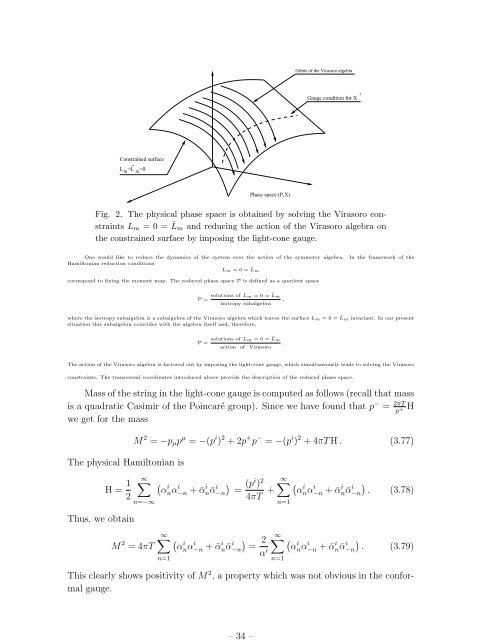Lectures on String Theory
Lectures on String Theory
Lectures on String Theory
Create successful ePaper yourself
Turn your PDF publications into a flip-book with our unique Google optimized e-Paper software.
– 34 –<br />
Orbits of the Virasoro algebra<br />
+<br />
Gauge c<strong>on</strong>diti<strong>on</strong> for X<br />
C<strong>on</strong>strained surface<br />
_<br />
L m =L m =0<br />
Phase space (P,X)<br />
Fig. 2. The physical phase space is obtained by solving the Virasoro c<strong>on</strong>straints<br />
L m = 0 = ¯L m and reducing the acti<strong>on</strong> of the Virasoro algebra <strong>on</strong><br />
the c<strong>on</strong>strained surface by imposing the light-c<strong>on</strong>e gauge.<br />
One would like to reduce the dynamics of the system over the acti<strong>on</strong> of the symmetry algebra.<br />
Hamilt<strong>on</strong>ian reducti<strong>on</strong> c<strong>on</strong>diti<strong>on</strong>s<br />
L m = 0 = ¯L m<br />
In the framework of the<br />
corresp<strong>on</strong>d to fixing the moment map. The reduced phase space P is defined as a quotient space<br />
P = soluti<strong>on</strong>s of L m = 0 = ¯L m<br />
isotropy subalgebra<br />
,<br />
where the isotropy subalgebra is a subalgebra of the Virasoro algebra which leaves the surface L m = 0 = ¯L m invariant. In our present<br />
situati<strong>on</strong> this subalgebra coincides with the algebra itself and, therefore,<br />
P = soluti<strong>on</strong>s of Lm = 0 = ¯L m<br />
acti<strong>on</strong> of Virasoro<br />
.<br />
The acti<strong>on</strong> of the Virasoro algebra is factored out by imposing the light-c<strong>on</strong>e gauge, which simultaneously leads to solving the Virasoro<br />
c<strong>on</strong>straints. The transversal coordinates introduced above provide the descripti<strong>on</strong> of the reduced phase space.<br />
Mass of the string in the light-c<strong>on</strong>e gauge is computed as follows (recall that mass<br />
is a quadratic Casimir of the Poincaré group). Since we have found that p − = 2πT H<br />
p +<br />
we get for the mass<br />
The physical Hamilt<strong>on</strong>ian is<br />
H = 1 2<br />
Thus, we obtain<br />
M 2 = −p µ p µ = −(p i ) 2 + 2p + p − = −(p i ) 2 + 4πT H . (3.77)<br />
∞∑<br />
n=−∞<br />
(<br />
α<br />
i<br />
n α i −n + ᾱ i nᾱ i −n)<br />
=<br />
(p i ) 2<br />
4πT + ∞<br />
∑<br />
n=1<br />
( )<br />
α<br />
i<br />
n α−n i + ᾱnᾱ i −n<br />
i . (3.78)<br />
M 2 = 4πT<br />
∞∑<br />
n=1<br />
(<br />
α<br />
i<br />
n α i −n + ᾱ i nᾱ i −n)<br />
=<br />
2<br />
α ′<br />
∞<br />
∑<br />
n=1<br />
( )<br />
α<br />
i<br />
n α−n i + ᾱnᾱ i −n<br />
i . (3.79)<br />
This clearly shows positivity of M 2 , a property which was not obvious in the c<strong>on</strong>formal<br />
gauge.

















